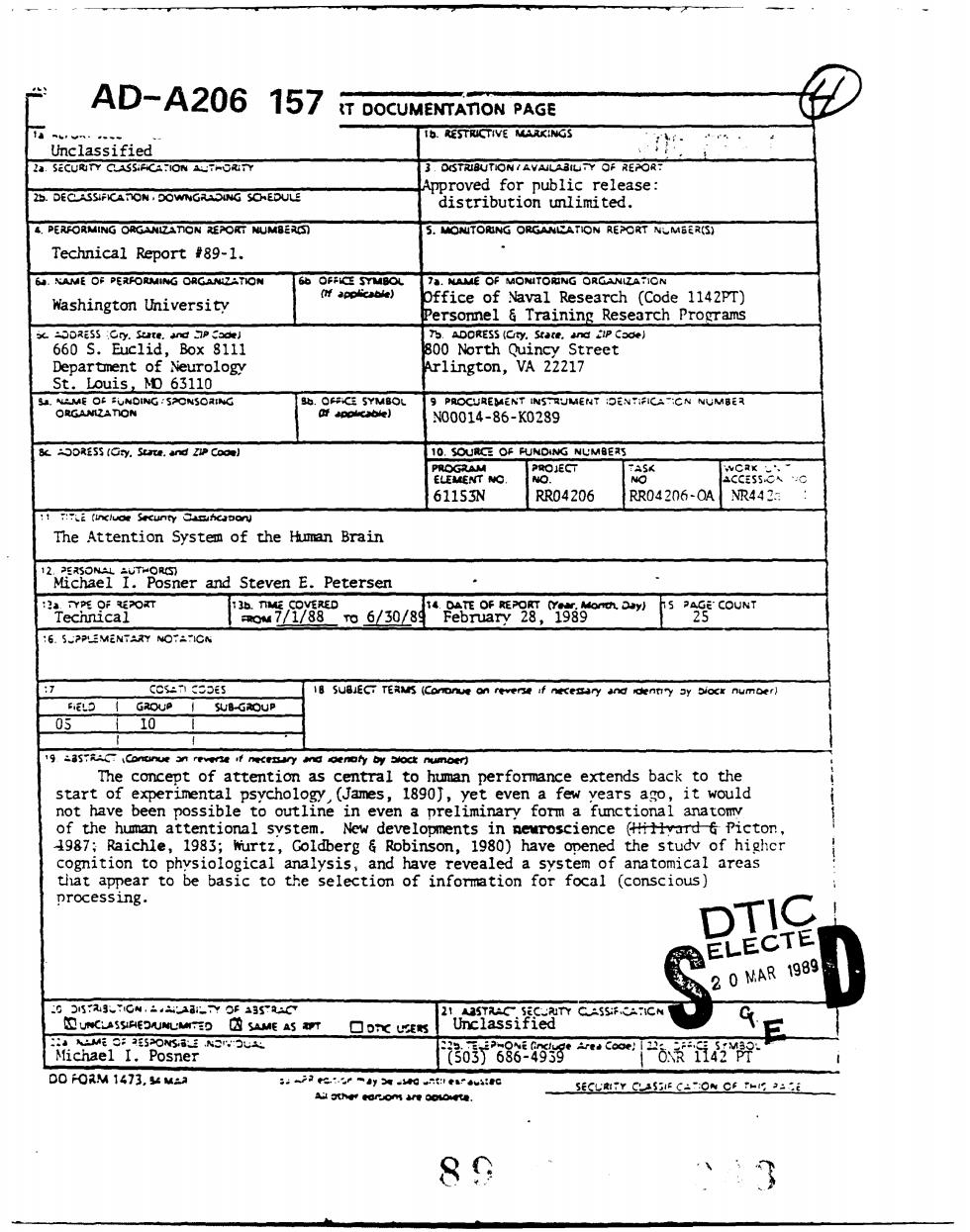
AD-A206 157 T DOCUMENTATION PAGE Unclassified 4 PERFORMING O☑ Technical Report #89-1. maT Washington University ersonnel 6 Training Research Programs 设,0 Ss 01486K0239 JMENT元NCA-CN NUMBE习 RESS (Gry.Sute.and Coo) 10.SOURCE OF PUNDING NLMBERS 5s 61153N RR04206RR04206-0AXR442 The Attention System of the Hman Brain and Steven E.Petersen Technicalo 05 10 19R Cononuee ny and ofnaly by Sock New icalanalysis.and have revealed DTIC ELECTE 20MAR1989 Uneiassc CC 活0j6336浴”o6煮置2学 DO FORM 1473.M 89
AD-A206 157 ,T DOCUMENTATION PAGE l. ESMTaCTIVE MAA NiGMS Unclassified O , ,"O" 2a SECURirY C-.SS.-..N 3. 0tSTRJ8UTIONIAVAiLf4IU ' Y OF REPORT Approved for public release: Z. DECLASS ICA-,ON 0ow,,Ja-NNG SO'UL-E distribution unlimited. 4. PERFOMING~ ORG-ANZATION RE.POR N4UM8FSM S. 'ACWTO6ING ORCJ6NLATION REPORT N4,MSER(S) Technical Report #89-1. 6,a. %rAME O; PERORMNG ORGAZ.ATION 6b OP;;IC SO . 7a. kAA OF MOW4TOmNG ORGANIZA-ION Washington University 'f , ffice of Naval Research (Code 1142PT) ersonnel & Training Research Prozrams .- .Z-0RESS [Cr. Sure. WWI -"7P odeJ b ADORESS (City. Sate. am :IP Cooe) 660 S. Euclid, Box 8111 00 North Quincy Street Department of Neurology lington, VA 22217 St. Louis IMD 63110 Ui. 14.Me 0; UNOLNG:SPOiS0;aIkG &b. 0"<:- SYMBOL 9PROCI EbAENT INS71MENT ON C;<A-CN NUMBER ORGANoZATION " N00014-86-K0289 5L ;O-ASS (0 y. Staw. and ZP Co=o) 10. SOURCI OF PIJNCNG NUMSERS PROKPAM PROJECT, rASK V- - ELEME1T NO. N O. .CFSS.c',, E '-'C '61153N RR04206 'RR04206-OA NR4422- 7!7L (rKIrLc' SeCURVY ?-fCa tPIco Vj The Attention System of the Human Brain 12. PERSONAL ALTi..ORM5 Michael I. Posner and Steven E. Petersen '2a. -,Y*.K OF REPORT 13b. flME COVERED 4. DATE OF REPORT (Y~. AionU',k. Day) 5 PA-GE'COUNT Technical mom 7/1/88 To 6§/30/8 February 28, 1989 25 "6. 5.PPLEM.NT.RY NO-"'I7GN :7 CCS,;.TI Z-.:ES I 1 6 SU8JECT TERMS (Caru om an 'e-,,se J ,eCeunay and ,lr,'-y my biocx numoer) riEL' GROUP ISUB-GROUP 05 1 10 I 11 Z-as-RAC7 kcanaermj ~ran .f PWV.~avy and 4IOty by -W=~ nufflaer The concept of attention as central to human performance extends back to the start of experimental psychology (James, 1890j, yet even a few years ago, it would not have been possible to outline in even a preliminary form a functional anatomy of the human attentional system. New developments in newrmscience (+H-lfnrd & Picton, 4987; Raichle, 1983; Wurtz, Goldberg & Robinson, 1980) have opened the study of highcr cognition to physiological analysis, and have revealed a system of anatomical areas that appear to be basic to the selection of information for focal (conscious) processing. ~ '5ig T -.. aa..y iai ~ ES~.'21 AISTUcC SiC.-Airv-,S;rC;-C MuwCL~ss-ieoDumuur-o sAme As wT 0 O7'C Unclassified :2a ,,. ;..Z F. C ,'': a=..SO . .. 2t= 'r .. ; :P O'tt. r, ,.t C:.e. C , + Michael 1. Posner I/ : r.,_ , o ,I 50m 686 -49A c oo . 1142 PT DO OQ W 1473, m-_a .- . . , : ..-. , e.: '.: sEcLMY C .;I, c"-:Oo c OFg , . - 89 x a
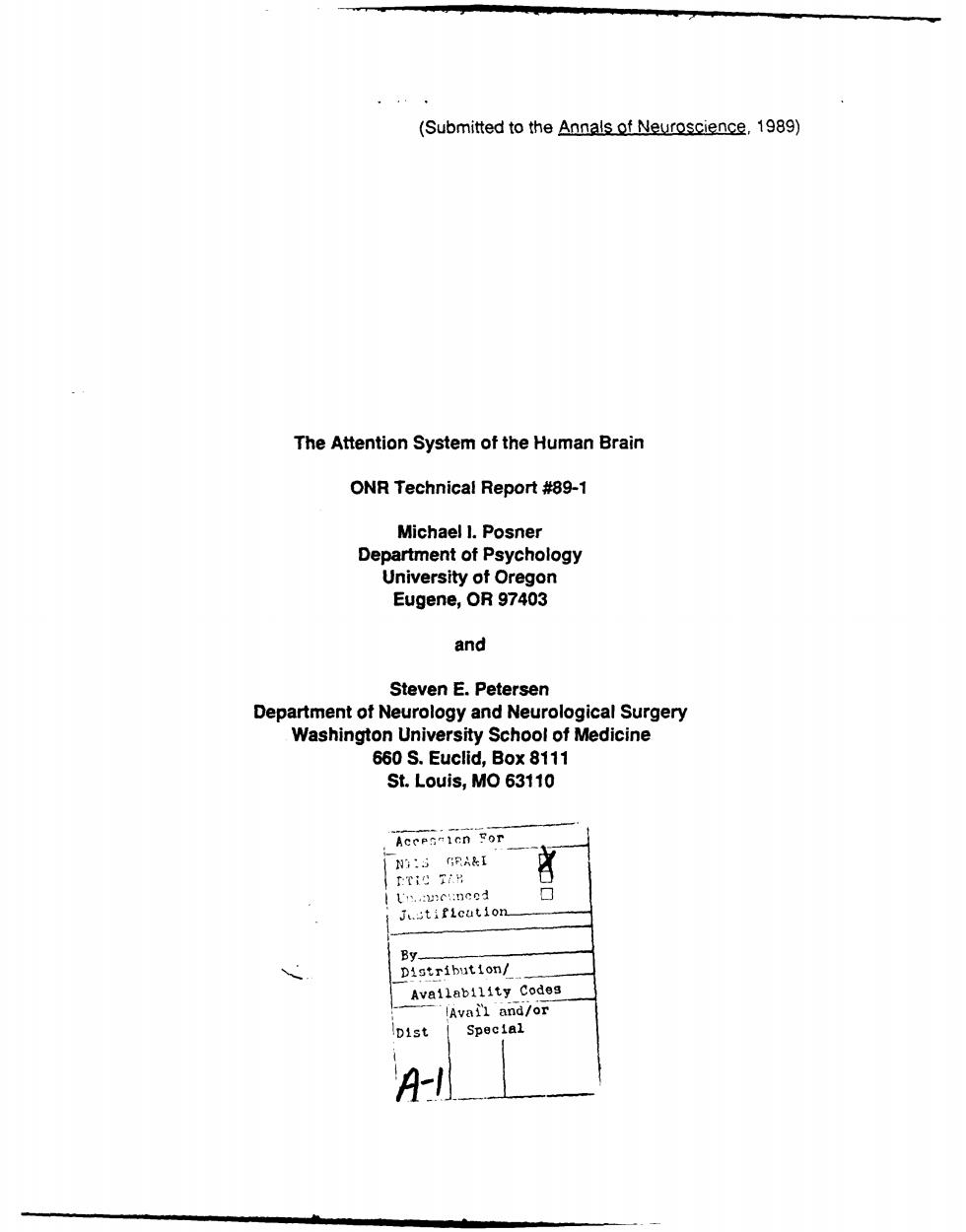
(Submitted to the Annals of Neuroscience,1989) The Attention System of the Human Brain ONR Technical Report #89-1 Michael l.Posner Department of Psychology 2oat0A97a38” and Steven E.Petersen Department of Neurology and Neurological Surgery Washington University School of Medicine 660S.Euclid,Box111 St.Louis,MO 63110 Acers-icn Por Distribution/ Availability Codes A
(Submitted to the Annals of Neuroscience, 1989) The Attention System of the Human Brain ONR Technical Report #89-1 Michael I. Posner Department of Psychology University of Oregon Eugene, OR 97403 and Steven E. Petersen Department of Neurology and Neurological Surgery Washington University School of Medicine 660 S. Euclid, Box 8111 St. Louis, MO 63110 B - n -n-o Availability Codes ; -Avai'l and/or IDist Special
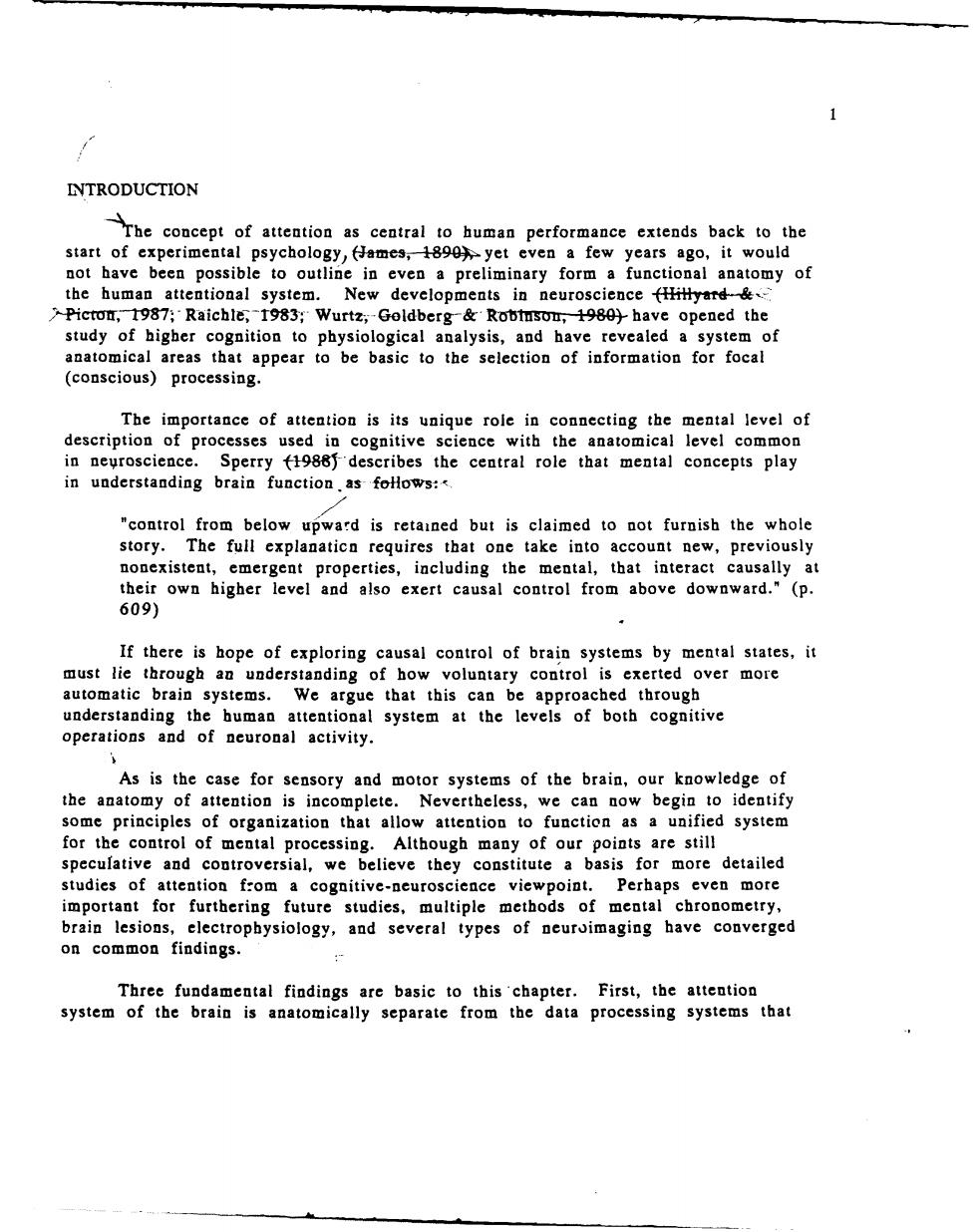
INTRODUCTION The concept of attention as central to human performance extends back to the start of experimental psychology,(ames,1890)yet even a few years ago,it would not have been possible to outline in even a preliminary form a functional anatomy of the human attentional system.New developments in neuroscience fHiHyard& Picton,1987:Raichle;-1983:Wurtz:-Goldberg&Robtnsom 1980)have opened the study of higher cognition to physiological analysis,and have revealed a system of anatomical areas that appear to be basic to the selection of information for focal (conscious)processing The importance of attention is its unique role in connecting the mental level of description of processes used in cognitive with the anate mical level common in neuroscience. Sperry (1988)de cribes the central role that mental concepts play in understanding brain function as fo "control from below story. Th full exp es,including the theisown higher level exert caua conto from above dowaward. ergen men (P 609) If there is hope of exploring causal control of brain systems by mental states,it must lie automatic ayeanirggglralege9peg6g6eraore th understanding the human attentional system at the levels of both cognitive operations and of neuronal activity. As is the case for sensory and motor systems of the brain,our knowledge of the anatomy of attention is incomplete.Nevertheless,we can now begin to identify some principles of organization that allow attention to function as a unified system for the control of mental processing.Although many of our points are still speculative and controversial,we believe they constitute a basis for more detailed studies of attention from a cognitive-neuroscience viewpoint.Perhaps even more important for furthering future studies,multiple methods of mental chronometry, brain lesions,electrophysiology,and several types of neurvimaging have converged on common findings. Three fundamental findings are basic to this'chapter.First,the attention system of the brain is anatomically separate from the data processing systems that
/ INTRODUCTION - lrhe concept of attention as central to human performance extends back to the start of experimental psychology, (,&mes,-44W,90 yet even a few years ago, it would not have been possible to outline in even a preliminary form a functional anatomy of the human attentional system. New developments in neuroscience '-'. 2 -Picroa,--1-9S7,- Raichk,-t983; Wurtz-Goldberg-& R - have opened the study of higher cognition to physiological analysis, and have revealed a system of anatomical areas that appear to be basic to the selection of information for focal (conscious) processing. The importance of attention is its unique role in connecting the mental level of description of processes used in cognitive science with the anatomical level common in nearoscience. Sperry tV98 'describes the central role that mental concepts play in understanding brain function. as- foHows: "control from below upward is retained but is claimed to not furnish the whole story. The full explanaticn requires that one take into account new, previously nonexistent, emergent properties, including the mental, that interact causally at their own higher level and also exert causal control from above downward." (p. 609) If there is hope of exploring causal control of brain systems by mental states, it must lie through an understanding of how voluntary control is exerted over more automatic brain systems. We argue that this can be approached through understanding the human attentional system at the levels of both cognitive operations and of neuronal activity. As is the case for sensory and motor systems of the brain, our knowledge of the anatomy of attention is incomplete. Nevertheless, we can now begin to identify some principles of organization that allow attention to function as a unified system for the control of mental processing. Although many of our points are still speculative and controversial, we believe they constitute a basis for more detailed studies of attention from a cognitive-neuroscience viewpoint. Perhaps even more important for furthering future studies, multiple methods of mental chronometry, brain lesions, electrophysiology, and several types of neuroimaging have converged on common findings. . Three fundamental findings are basic to this chapter. First, the attention system of the brain is anatomically separate from the data processing systems that
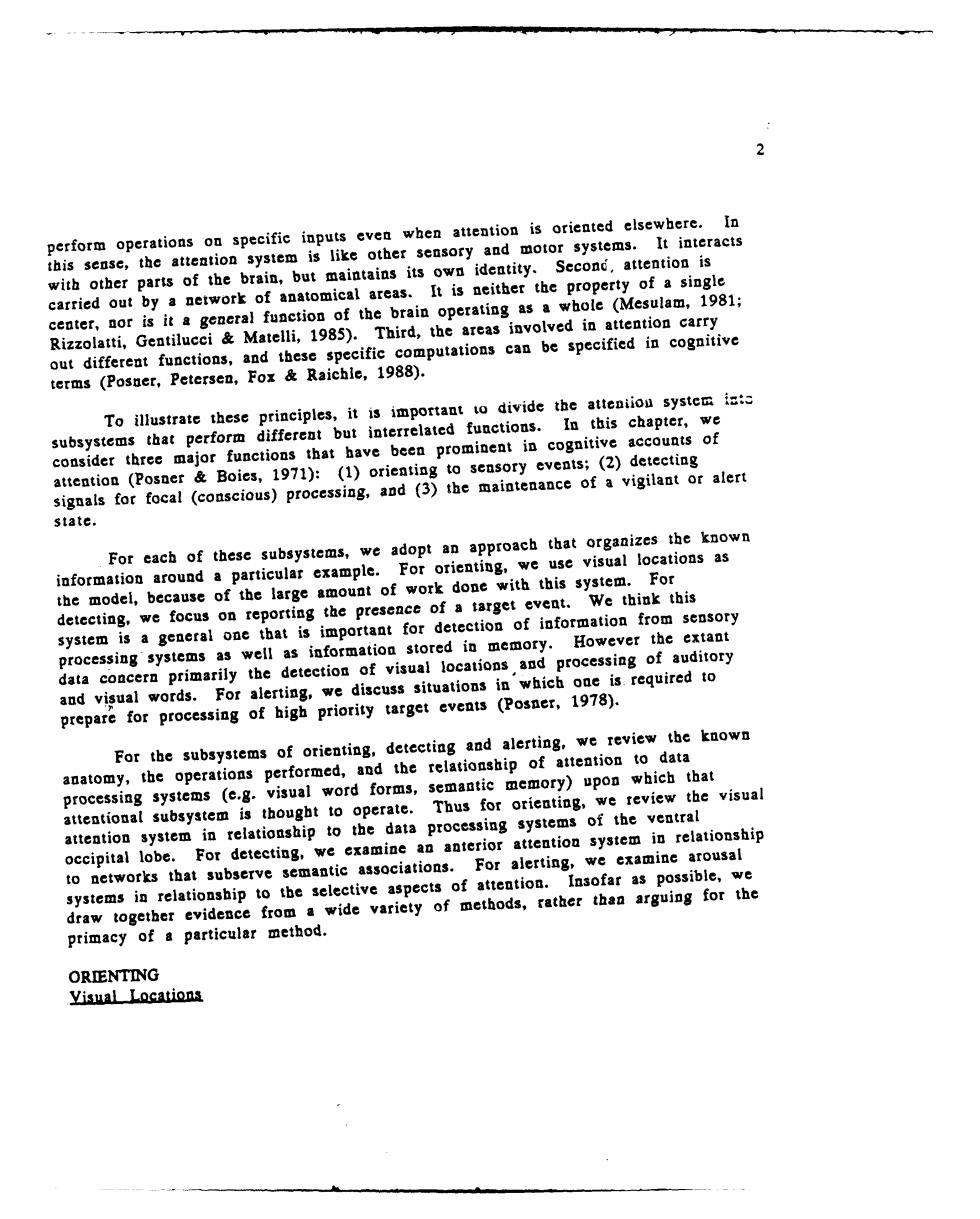
a when attention is oriented elsewhere. interacts with other parts of the brain maintains its own identity. of a single carried out by a network of the brain operatinged in attention carry ceater,orsMatei.9).Third,the Rizzolatti,Ge and these specific computations can be specified in cognitive n For Raichle,1988) tem ists To illustrate these principles,it is imp elated functions. syst we have been prominent in cogni attention (Posner B (1)orienting to seasory :(2)detecting signals for focal(conscio essing and (3)the mainte eveofa vigilant or alert state. For each of these subsystems,we adopt an und a particular example. of the arge of k done with this system nk this we focus on reporti ag tae p for detection of information om sensory tion stored in memory. er the extant data concern pri of visual locations,an and visual words we discuss situations in required to prepare for processing of bigh priority target events (Po 19781 For the subsystems of orienting,detecting and alerting,we review the kaown erations performed,and the aship of aitention to ems (e.g.visual word for memory)upon subsystem is thought to opera Thus for orienting, the visual system in relationship to the cessing systems of an anterior attention syste in relationship cipital lobe.For detecting, to networks that subserve se associations.For alerting, amine arousal ive aspects of attention. as possible,we a wide variety of methods,rather than arguing for the draw together evid primacy of a particular method
2 perform operations on specific inputs even when attention is oriented elsewhere. In this sense, the attention system is like other sensory and motor systems. It interacts with other parts of the brain, but maintains its own identity. SeconC, attention is carried out by a network of anatomical areas. It is neither the property of a single center, nor is it a general function of the brain operating as a whole (Mesulam, 1981; Rizzolatti, Gentilucci & Matelli, 1985). Third, the areas involved in attention carry out different functions, and these specific computations can be specified in cognitive terms (Posner, Petersen, Fox & Raichle, 1988). To illustrate these principles, it is important to divide the attenDti systC i-z subsystems that perform different but interrelated functions. In this chapter, we consider three major functions that have been prominent in cognitive accounts of attention (Posner & Boies, 1971): (1) orienting to sensory events; (2) detecting signals for focal (conscious) processing, and (3) the maintenance of a vigilant or alert state. For each of these subsystems, we adopt an approach that organizes the known information around a particular example. For orienting, we use visual locations as the model, because of the large amount of work done with this system. For detecting, we focus on reporting the presence of a target event. We think this system is a general one that is important for detection of information from sensory processing systems as well as information stored in memory. However the extant data concern primarily the detection of visual locations and processing of auditory and visual words. For alerting, we discuss situations in which one is required to prepare for processing of high priority target events (Posner, 1978). For the subsystems of orienting, detecting and alerting, we review the known anatomy, the operations performed, and the relationship of attention to data processing systems (e.g. visual word forms, semantic memory) upon which that attentional subsystem is thought to operate. Thus for orienting, we review the visual attention system in relationship to the data processing systems of the ventral occipital lobe. For detecting, we examine an anterior attention system in relationship to networks that subserve semantic associations. For alerting, we examine arousal systems in relationship to the selective aspects of attention. Insofar as possible, we draw together evidence from a wide variety of methods, rather than arguing for the primacy of a particular method. ORIENTING Visual Loations
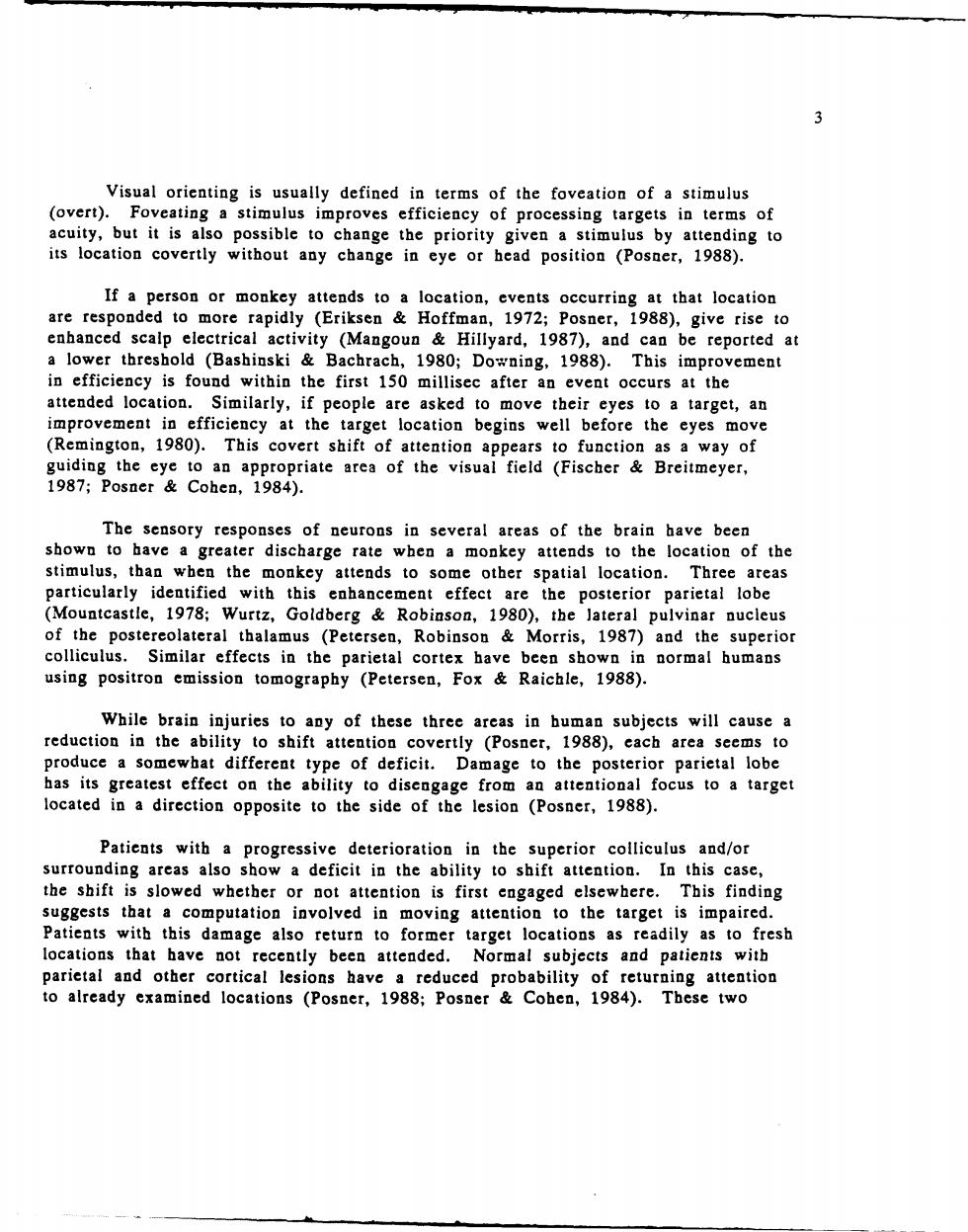
Visual orienting is usually defined in terms of the foveation of a stimulus (overt).Foveating a stimulus improves effici acy of pr or head position (Posmer,1988). If a person or monkey attends to a location,events occurring at that location are responded to more rapidly (Eriksen Hoffman,1972;Posner,1988),give rise to emhanced scalp electrical activity (,1987).be reporteda a lower threshold (Bashinski Bachrach.1980:Do ing,1988). This in efficiency is found within the first 150 millisec an rs a attended location.Similarly people are ed to m eye target,an improvement in efficiene .th rge begins wel (Remin gton,1980).This e cyes mo the cove rt shif a 1 idin。 ention appear 9 a way of 9s7oaer hen, of neurons in several areas shown to hay of the brain have been when a mor stimulus,than grea arge rat key atten to the location of the cy att effe other to son articularly spatial locati with th 1978 Goldberg& inson,19 30),the lateral pulvinar nucleus thalamus (Petersen,Robinson Morris,1987)and the superior ilar effects in the parietal cortex have been shown in normal humans using positron emission tomography (Petersen,Fox Raichle.1989). While brain injuries to any of these three areas in buman subjects will cause a reduction in the ability to shift attention covertly (Posner,1988),cach area seems to produce a somewhat different type of deficit.Damage to the posterior parietal lobe has its greatest effect on the ability to disengage from an attentional focus to a target located in a direction opposite to the side of the lesion (Posner,1988). Patients with a progressive deterioration in the superior colliculus and/or surrounding areas also show a deficit in the ability to shift attention.In this case, the shift is slowed whether or not attention is first engaged elsewhere.This finding suggests that a computation involved in moving attention to the target is impaired. Patients with this damage also return to former target locations as readily as to fresh locations that have not recently been attended.Normal subjects and patients with parietal and other cortical lesions have a reduced probability of returning attention to already examined locations (Posner,1988;Posner&Cohen,1984).These two
3 Visual orienting is usually defined in terms of the foveation of a stimulus (overt). Foveating a stimulus improves efficiency of processing targets in terms of acuity, but it is also possible to change the priority given a stimulus by attending to its location covertly without any change in eye or head position (Posner, 1988). If a person or monkey attends to a location, events occurring at that location are responded to more rapidly (Eriksen & Hoffman, 1972; Posner, 1988), give rise to enhanced scalp electrical activity (Mangoun & Hillyard, 1987), and can be reported at a lower threshold (Bashinski & Bachrach, 1980; Downing, 1988). This improvement in efficiency is found within the first 150 millisec after an event occurs at the attended location. Similarly, if people are asked to move their eyes to a target, an improvement in efficiency at the target location begins well before the eyes move (Remington, 1980). This covert shift of attention appears to function as a way of guiding the eye to an appropriate area of the visual field (Fischer & Breitmeyer, 1987; Posner & Cohen, 1984). The sensory responses of neurons in several areas of the brain have been shown to have a greater discharge rate when a monkey attends to the location of the stimulus, than when the monkey attends to some other spatial location. Three areas particularly identified with this enhancement effect are the posterior parietal lobe (Mountcastle, 1978; Wurtz, Goldberg & Robinson, 1980), the lateral pulvinar nucleus of the postereolateral thalamus (Petersen, Robinson & Morris, 1987) and the superior colliculus. Similar effects in the parietal cortex have been shown in normal humans using positron emission tomography (Petersen, Fox & Raichle, 1988). While brain injuries to any of these three areas in human subjects will cause a reduction in the ability to shift attention covertly (Posner, 1988), each area seems to produce a somewhat different type of deficit. Damage to the posterior parietal lobe has its greatest effect on the ability to disengage from an attentional focus to a target located in a direction opposite to the side of the lesion (Posner, 1988). Patients with a progressive deterioration in the superior colliculus and/or surrounding areas also show a deficit in the ability to shift attention. In this case, the shift is slowed whether or not attention is first engaged elsewhere. This finding suggests that a computation involved in moving attention to the target is impaired. Patients with this damage also return to former target locations as readily as to fresh locations that have not recently been attended. Normal subjects and patients with parietal and other cortical lesions have a reduced probability of returning attention to already examined locations (Posner, 1988; Posner & Cohen, 1984). These two
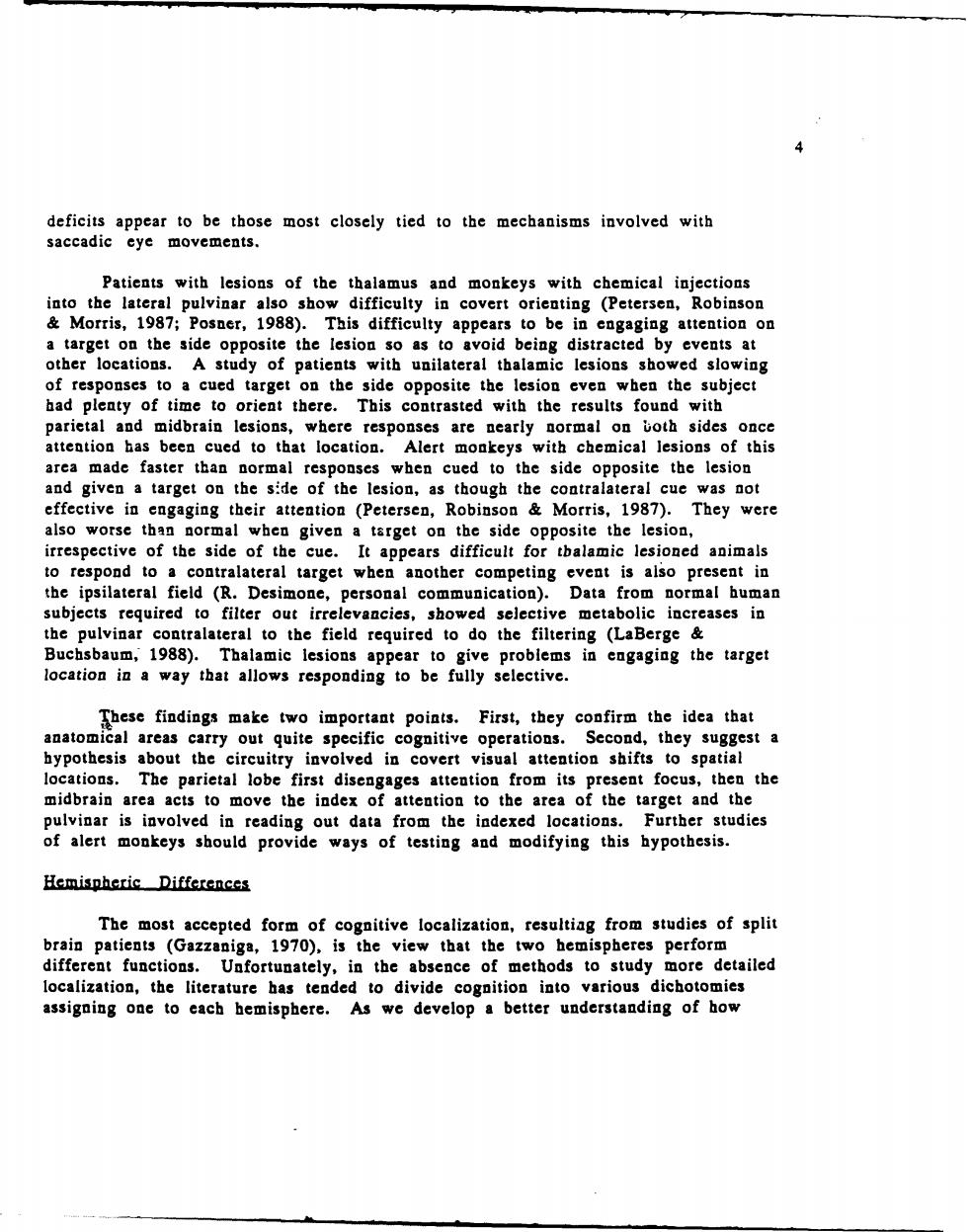
deficits appear to be those most closely tied to the mechanisms involved with saccadic eye movements. Patients with lesions of the thalamus and monkeys with chemical injections into the lateral pulvinar also show difficulty in covert orienting (Petersen,Robinson Morris,1987;Posner,1988).This difficulty appears to be in engaging attention on a target on the side opposite the lesion so as to avoid being distracted by events at other locations.A study of patients with unilateral thalamic lesions showed slowing of responses to a cued target on the side opposite the lesion even when the subject had plenty of time to orient there.This contrasted with the results found with parietal and midbrain lesions,where responses are nearly normal on both sides once attention has been cued to that location.Alert monkeys with chemical lesions of this area made faster than normal responses when cued to the side opposite the lesion and given a target on the side of the lesion,as though the contralateral cue was not effective in engaging their attention (Petersen,Robinson Morris,1987).They were also worse than normal when given a tsrget on the side opposite the lesion, irrespective of the side of the cue.It appears difficult for tbalamic lesioned animals to respond to a contralateral target when another competing event is also present in the ipsilateral field (R.Desimone,personal communication).Data from normal buman subjects required to filter out irrelevancies,showed selective metabolic increases in the pulvinar contralateral to the field required to do the filtering (LaBerge Buchsbaum,1988). Thalamic lesions appear to give probiems in engaging the target location in a way that allows responding to be fully selective. First,they confirm the idea that areas ca sis rry out quite speci cognitive operations try ved in covert attention shifts to spat midb The parietal lobe first 03, the the move the index of attentio the the targe and ar is lnvolve out data studies ler monkeys should provide ways of testing and modifying this The most accepted fo diffe 8a, 9 ately etailed 100 re to div we develop a aee erst nding of how
4 deficits appear to be those most closely tied to the mechanisms involved with saccadic eye movements. Patients with lesions of the thalamus and monkeys with chemical injections into the lateral pulvinar also show difficulty in covert orienting (Petersen, Robinson & Morris, 1987; Posner, 1988). This difficulty appears to be in engaging attention on a target on the side opposite the lesion so as to avoid being distracted by events at other locations. A study of patients with unilateral thalamic lesions showed slowing of responses to a cued target on the side opposite the lesion even when the subject had plenty of time to orient there. This contrasted with the results found with parietal and midbrain lesions, where responses are nearly normal on both sides once attention has been cued to that location. Alert monkeys with chemical lesions of this area made faster than normal responses when cued to the side opposite the lesion and given a target on the s:de of the lesion, as though the contralateral cue was not effective in engaging their attention (Petersen, Robinson & Morris, 1987). They were also worse than normal when given a target on the side opposite the lesion, irrespective of the side of the cue. It appears difficult for tbalamic lesioned animals to respond to a contralateral target when another competing event is also present in the ipsilateral field (R. Desimone, personal communication). Data from normal human subjects required to filter out irrelevancies, showed selective metabolic increases in the pulvinar contralateral to the field required to do the filtering (LaBerge & Buchsbaum. 1988). Thalamic lesions appear to give problems in engaging the target location in a way that allows responding to be fully selective. These findings make two important points. First, they confirm the idea that anatomical areas carry out quite specific cognitive operations. Second, they suggest a hypothesis about the circuitry involved in covert visual attention shifts to spatial locations. The parietal lobe first disengages attention from its present focus, then the midbrain area acts to move the index of attention to the area of the target and the pulvinar is involved in reading out data from the indexed locations. Further studies of alert monkeys should provide ways of testing and modifying this hypothesis. Hemispheric Differences The most accepted form of cognitive localization, resultiag from studies of split brain patients (Gazzaniga, 1970), is the view that the two hemispheres perform different functions. Unfortunately, in the absence of methods to study more detailed localization, the literature has tended to divide cognition into various dichotomies assigning one to each hemisphere. As we develop a better understanding of how
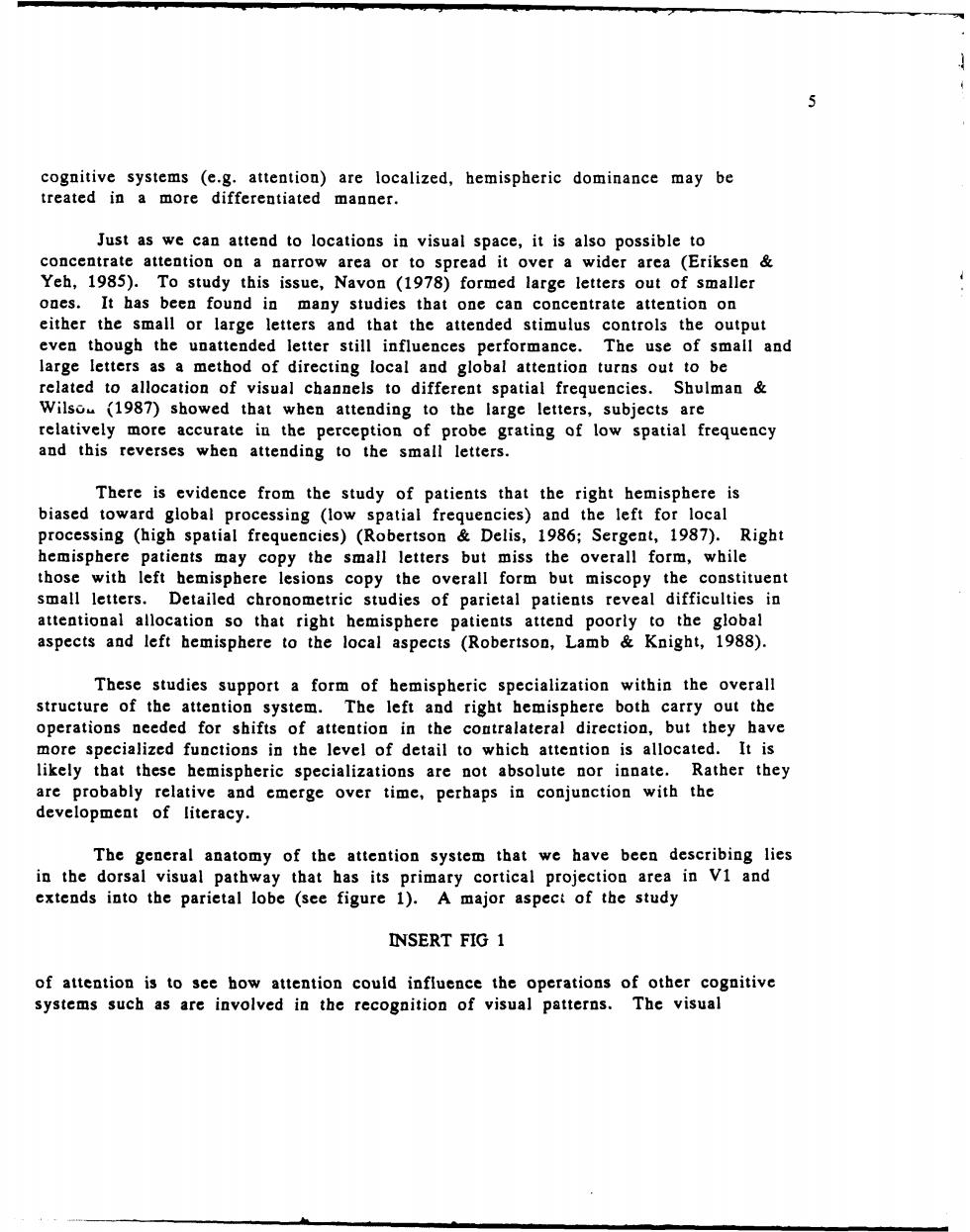
5 cognitive systems (e.g.attention)are localized,hemispheric dominance may be treated in a more differentiated manner. Just as we can attend to locations in visual space,it is also possible to concentrate attention on a narrow area or to spread it over a wider area(Eriksen Yeh,1985). To study this issue,Navon (1978)formed large letters out of smaller ones.It has been found in many studies that one can concentrate attention on either the small or large letters and that the attended stimulus controls the output even though the unattended letter still influences performance.The use of small and large letters as a method of directing local and global attention turns out to be related to allocation of visual channels to different spatial frequencies.Shulman& Wilso(1987)showed that when attending to the large letters,subjects are relatively more accurate in the perception of probe grating of low spatial frequency and this reverses when attending to the small letters. There is evidence from the study of patients that the right hemisphere is biased toward global processing (low spatial frequencies)and the left for local processing (high spatial frequencies)(Robertson Delis,1986;Sergent,1987).Right hemisphere patients may copy the small letters but miss the overall form,while those with left hemisphere lesions copy the overall form but miscopy the constituent small letters.Detailed chronometric studies of parietal patients reveal difficulties in attentional allocation so that right hemisphere patients attend poorly to the global aspects and left hemisphere to the local aspects (Robertson,Lamb Knight,1988). These studies support a form of hemispheric specialization within the overall structure of the attention system.The left and right hemisphere both carry out the operations needed for shifts of attention in the coutralateral direction.but they have more specialized functions in the level of detail to which attention is allocated.It is likely that these hemis ecializations are not absolute Rather they are probably relative nd cmerge over time,perhaps in conjunction with the development of literacy. my of the atter system tha we have been describing lies in the do isual pat primary proje a in v1 and extends into the parietal lobe (sce figure 1). A major aspeci INSERT FIG 1 the operations of other cognitive visual patterns. visua
5 cognitive systems (e.g. attention) are localized, hemispheric dominance may be treated in a more differentiated manner. Just as we can attend to locations in visual space, it is also possible to concentrate attention on a narrow area or to spread it over a wider area (Eriksen & Yeh, 1985). To study this issue, Navon (1978) formed large letters out of smaller ones. It has been found in many studies that one can concentrate attention on either the small or large letters and that the attended stimulus controls the output even though the unattended letter still influences performance. The use of small and large letters as a method of directing local and global attention turns out to be related to allocation of visual channels to different spatial frequencies. Shulman & Wilson. (1987) showed that when attending to the large letters, subjects are relatively more accurate in the perception of probe grating of low spatial frequency and this reverses when attending to the small letters. There is evidence from the study of patients that the right hemisphere is biased toward global processing (low spatial frequencies) and the left for local processing (high spatial frequencies) (Robertson & Delis, 1986; Sergent, 1987). Right hemisphere patients may copy the small letters but miss the overall form, while those with left hemisphere lesions copy the overall form but miscopy the constituent small letters. Detailed chronometric studies of parietal patients reveal difficulties in attentional allocation so that right hemisphere patients attend poorly to the global aspects and left hemisphere to the local aspects (Robertson, Lamb & Knight, 1988). These studies support a form of hemispheric specialization within the overall structure of the attention system. The left and right hemisphere both carry out the operations needed for shifts of attention in the contralateral direction, but they have more specialized functions in the level of detail to which attention is allocated. It is likely that these hemispheric specializations are not absolute nor innate. Rather they are probably relative and emerge over time, perhaps in conjunction with the development of literacy. The general anatomy of the attention system that we have been describing lies in the dorsal visual pathway that has its primary cortical projection area in V1 and extends into the parietal lobe (see figure 1). A major aspect of the study INSERT FIG 1 of attention is to see how attention could influence the operations of other cognitive systems such as are involved in the recognition of visual patterns. The visual
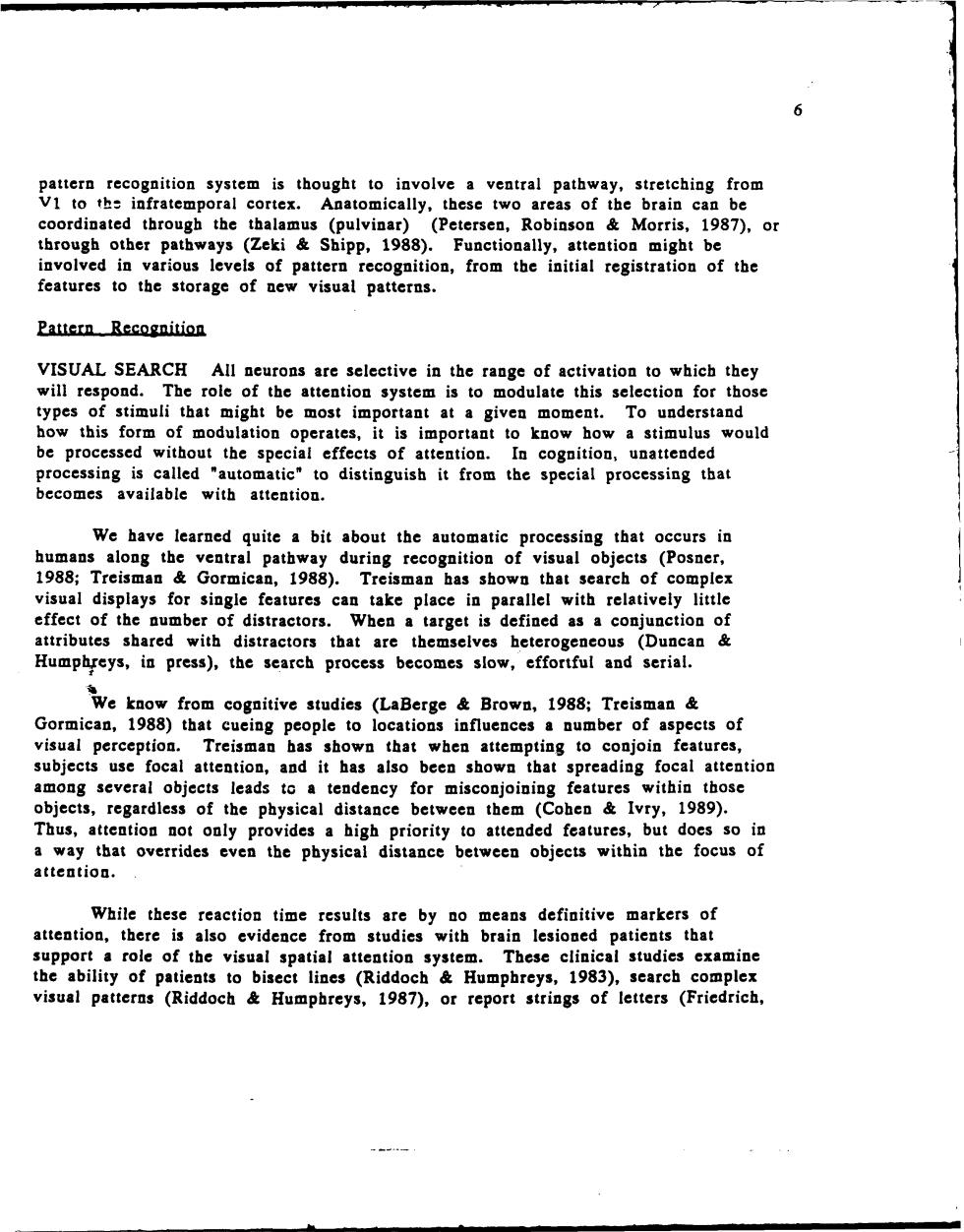
6 ttern reco is thou thes coordinated through the thalamus (pulvinar) (Peterser Robinson Mo 3,1987).or through other pathways (Zeki&Shipp 10只g1 Hh2aEoHo074oa2x22ae7CAm0nPR0A attention t be istration of the features to the storage of new visual patterns. Pattern recognition ARou All neurons are selectve in the range of activation to will respond.The role of the att is to m dulate this selection for those might be most imp nt To understand it is im how a stim ulus would be processed without the special effects of att In c nition,unattended 8ceGoengnedagomioantsiagahtoaac cial processing that We have learned quite a bit about the automatic processing that occurs in humans along the ventral patbway during recognition of visual objects (Posner 1988;Treisman Gormican,1988). Treisman has sho、 n that tearch of comnle visual displays for single features can take place in arallel with relatively little effect of the number of distract When a tar et is defined as a conjunction of attributes shared with distractors that are ther (Duncan Humphpeys,in press),the search process becomes slow,efforful and serial. We kaow from cognitive studies (LaBerge&Brown,198:Treisman Gormican,1988)that cu ple to locatic ces a number of aspects of visual perception. has shown that when attempting to e subjects use focal attention. and it has also beer sho hat spreading focal attention among several obiects leads to mis features within those obiects.r egardless of the ical distan .h y (Cohe &Iv ,1989). only pro t does so in a wav that de even the physical distance hin the focus of attenti a. While these reaction time results are by definitive eviden ies with of vis his att amine visual Riddo nes (Ri Humphreys,1987),or report strings of
6 pattern recognition system is thought to involve a ventral pathway, stretching from V1 to th: infratemporal cortex. Anatomically, these two areas of the brain can be coordinated through the thalamus (pulvinar) (Petersen, Robinson & Morris, 1987), or through other pathways (Zeki & Shipp, 1988). Functionally, attention might be involved in various levels of pattern recognition, from the initial registration of the features to the storage of new visual patterns. Pattern Recoanition VISUAL SEARCH All neurons are selective in the range of activation to which they will respond. The role of the attention system is to modulate this selection for those types of stimuli that might be most important at a given moment. To understand how this form of modulation operates, it is important to know how a stimulus would be processed without the special effects of attention. In cognition, unattended processing is called "automatic" to distinguish it from the special processing that becomes available with attention. We have learned quite a bit about the automatic processing that occurs in humans along the ventral pathway during recognition of visual objects (Posner, 1988; Treisman & Gormican, 1988). Treisman has shown that search of complex visual displays for single features can take place in parallel with relatively little effect of the number of distractors. When a target is defined as a conjunction of attributes shared with distractors that are themselves heterogeneous (Duncan & Humph reys, in press), the search process becomes slow, effortful and serial. We know from cognitive studies (LaBerge & Brown, 1988; Treisman & Gormican, 1988) that cueing people to locations influences a number of aspects of visual perception. Treisman has shown that when attempting to conjoin features, subjects use focal attention, and it has also been shown that spreading focal attention among several objects leads to a tendency for misconjoining features within those objects, regardless of the physical distance between them (Cohen & Ivry, 1989). Thus, attention not only provides a high priority to attended features, but does so in a way that overrides even the physical distance between objects within the focus of attention. While these reaction time results are by no means definitive markers of attention, there is also evidence from studies with brain lesioned patients that support a role of the visual spatial attention system. These clinical studies examine the ability of patients to bisect lines (Riddoch & Humphreys, 1983), search complex visual patterns (Riddoch & Humphreys, 1987), or report strings of letters (Friedrich
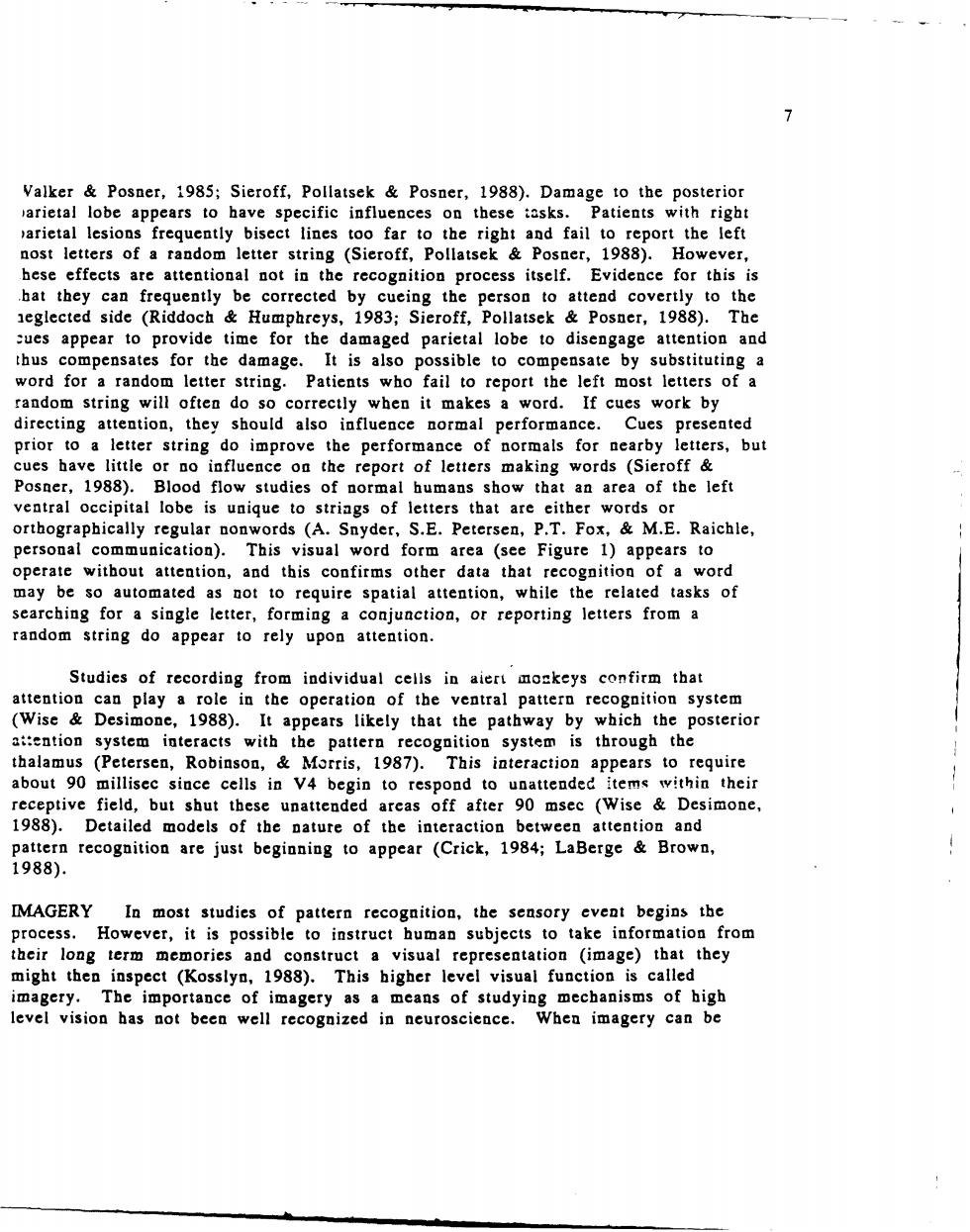
Valker Posner,1985;Sieroff,Pollatsek Posner,1988).Damage to the posterior arietal lobe appears to have specific influences on these tasks. Patients with rigbt parietal lesions frequently bisect lines far to the right and fail to report the left nost letters of a tandom letter string (Sieroff,Pollatsek Posner,1988).However. hese effects are attentional not in the recognition process itself.Evidence for this is hat they can frequently be corrected by cueing the person to attend covertly to the neglected side (Riddoch Humphreys,1983:Sieroff,Pollatsek Posner,1988).The cues appear to provide time for the damaged parietal lobe to disengage attention and thus e pensates for the damage It is also ssible to substituting word for a random letter Patients ho fail to report the left most letters of a tring will do it o ord by should etter d mpro per TS, but uen 1988). report letters of n area left le y & ME Raichle, a Figure with oper 6 ut this contirm tha not to require spatial att sks of rching single letter,forming a conjunct or reporting letters from a random string do appear to rely upon attention. Studies of recording from individual cells in aiert mokeys confirm that attent can play a role in the operation of the ventral pattern recognition system (Wise Desimone,1988).It appears likely that the pathway by which the posterior aiention system interacts with the pattern recognition system is through the thalamus (Petersen,Robinson,Morris,1987).This interaction appears to require about 90 millisec since cells in v4 begin to respond to unattended items within their receptive field,but shut these unattended areas off after 90 msec (Wise Desimone. 1988).Detailed models of the nature of the interaction between attention and pattern recognition are just beginning to appear (Crick,1984;LaBerge Brown, 1988). [MAGERY In most studies of pattern recognition,the sensory event begins the process.However,it is possible to instruct human subjects to take information from their long term memories and construct a visual representation (image)that they might then inspect (Kosslyn,1988).This bigher level visual function is called imagery.The importance of imagery as a means of studying mechanisms of high level vision has not been well recognized in neuroscience. When imagery can be
7 Valker & Posner, 1985; Sieroff, Pollatsek & Posner, 1988). Damage to the posterior )arietal lobe appears to have specific influences on these tasks. Patients with right )arietal lesions frequently bisect lines too far to the right and fail to report the left nost letters of a random letter string (Sieroff, Pollatsek & Posner, 1988). However, hese effects are attentional not in the recognition process itself. Evidence for this is hat they can frequently be corrected by cueing the person to attend covertly to the ,eglected side (Riddoch & Humphreys, 1983; Sieroff, Pollatsek & Posner, 1988). The :ues appear to provide time for the damaged parietal lobe to disengage attention and thus compensates for the damage. It is also possible to compensate by substituting a word for a random letter string. Patients who fail to report the left most letters of a random string will often do so correctly when it makes a word. If cues work by directing attention, they should also influence normal performance. Cues presented prior to a letter string do improve the performance of normals for nearby letters, but cues have little or no influence on the report of letters making words (Sieroff & Posner, 1988). Blood flow studies of normal humans show that an area of the left ventral occipital lobe is unique to strings of letters that are either words or orthographically regular nonwords (A. Snyder, S.E. Petersen, P.T. Fox, & M.E. Raichle, personal communication). This visual word form area (see Figure 1) appears to operate without attention, and this confirms other data that recognition of a word may be so automated as not to require spatial attention, while the related tasks of searching for a single letter, forming a conjunction, or reporting letters from a random string do appear to rely upon attention. Studies of recording from individual cells in aiert monkeys confirm that attention can play a role in the operation of the ventral pattern recognition system (Wise & Desimone, 1988). It appears likely that the pathway by which the posterior a.:ention system interacts with the pattern recognition systew is through the thalamus (Petersen, Robinson, & Morris, 1987). This interaction appears to require about 90 millisec since cells in V4 begin to respond to unattended ltermq within their receptive field, but shut these unattended areas off after 90 msec (Wise & Desimone, 1988). Detailed models of the nature of the interaction between attention and pattern recognition are just beginning to appear (Crick, 1984; LaBerge & Brown, 1988). IMAGERY In most studies of pattern recognition, the sensory event begins the process. However, it is possible to instruct human subjects to take information from their long term memories and construct a visual representation (image) that they might then inspect (Kosslyn, 1988). This higher level visual function is called imagery. The importance of imagery as a means of studying mechanisms of high level vision has not been well recognized in neuroscience. When imagery can be
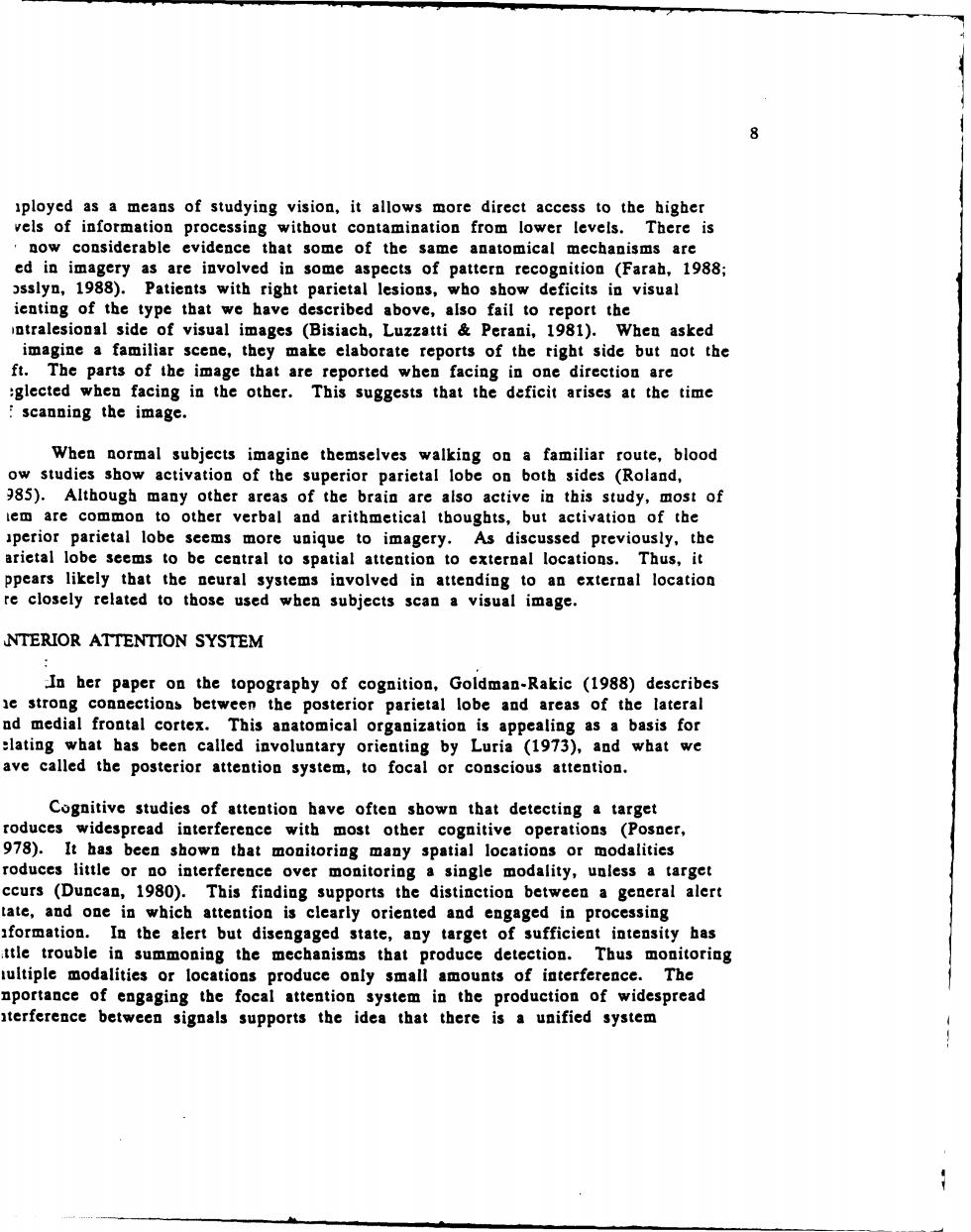
8 ployed as a means of studying vision,it allows more direct access to the higher vels of information processing without contamination from lower levels.There is considerable evidence that some of the same anatomical mechanisms are imagery as are involved in some aspects of pattern recognition (Farab,1988; osslyn,1988). Patients with right parietal lesions,who show deficits in visual ienting of the type we have described above,also fail to report the ntrales of visual images (Bisiach,Luzzatti Perani,1981).Whea asked a a nc, they make elaborate reports of the right side but not the :glecte paris of the are reported when facing in one direction are This suggests that the deficit arises at the time scanning the image rmal sub) imag ine the selves ing on fami route, blood activa up parieta (Roland, 85) ug study.m of ghts the pe 10 gery. 93 previously,the o pa terna ati pcoselytela involved attend ing to an external location when subjects scan a visual image NTERIOR ATTENTION SYSTEM ber paper on the topog of」 cogni a-Rakic (1988) de lob cribes medial and tex alled appe olu -ur1a1973 ave called the posterior attention system,to focs g by conscious attention Cognitive ave ofter shown tha detec 78. It haa oduces little curs (Duncan 10g ral aler ate.and one in which d the h ttle trouble in he ultiple pro modalities of interfer The of he widespread erference the de ys hat there unified 4 system
8 iployed as a means of studying vision, it allows more direct access to the higher vels of information processing without contamination from lower levels. There is now considerable evidence that some of the same anatomical mechanisms are ed in imagery as are involved in some aspects of pattern recognition (Farah, 1988; 3sslyn, 1988). Patients with right parietal lesions, who show deficits in visual ienting of the type that we have described above, also fail to report the intralesional side of visual images (Bisiach, Luzzatti & Perani, 1981). When asked imagine a familiar scene, they make elaborate reports of the right side but not the ft. The parts of the image that are reported when facing in one direction are -glected when facing in the other. This suggests that the deficit arises at the time scanning the image. When normal subjects imagine themselves walking on a familiar route, blood ow studies show activation of the superior parietal lobe on both sides (Roland, ?85). Although many other areas of the brain are also active in this study, most of tern are common to other verbal and arithmetical thoughts, but activation of the iperior parietal lobe seems more unique to imagery. As discussed previously, the arietal lobe seems to be central to spatial attention to external locations. Thus, it ppears likely that the neural systems involved in attending to an external location re closely related to those used when subjects scan a visual image. ,NTERIOR ATTENTION SYSTEM In her paper on the topography of cognition, Goldman-Rakic (1988) describes le strong connectionb between the posterior parietal lobe and areas of the lateral ad medial frontal cortex. This anatomical organization is appealing as a basis for elating what has been called involuntary orienting by Luria (1973), and what we ave called the posterior attention system, to focal or conscious attention. Cognitive studies of attention have often shown that detecting a target roduces widespread interference with most other cognitive operations (Posner, 978). It has been shown that monitoring many spatial locations or modalities roduces little or no interference over monitoring a single modality, unless a target ccurs (Duncan, 1980). This finding supports the distinction between a general alert Late, and one in which attention is clearly oriented and engaged in processing ,formation. In the alert but disengaged state, any target of sufficient intensity has ttle trouble in summoning the mechanisms that produce detection. Thus monitoring iultiple modalities or locations produce only small amounts of interference. The nportance of engaging the focal attention system in the production of widespread iterference between signals supports the idea that there is a unified system